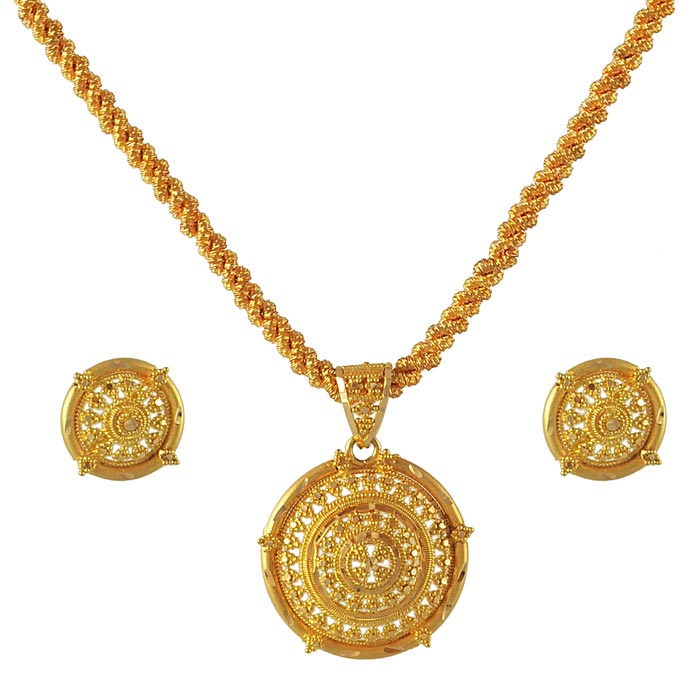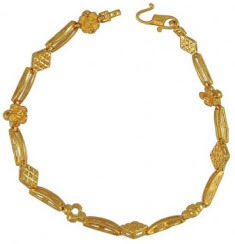Indian Jewelry Set Biography
Source
(google.com.pk)
Indian jewelry, like all other crafts of the nation, is inherently rooted in its spiritual depths. At one level, the ornamentation of the body is symbolic of an inner adorning which presupposes a certain amount of purity and cleanliness. Indian scriptures are clear in stating that a woman should always keep herself well adorned, it being necessary for the well-being of the whole house.
The grammar of ornament has always been well developed in India and there is a piece of jewel for nearly each part of the body. In total sixteen such ornaments have been delineated, starting from the head with the forehead ornament known as mang-tika and ending at the feet with the anklet and toe-ring. Collectively this group of jewellery is known as solah-shringar.
Traditionally, Indian jewelry has always consisted of motifs rich in symbolism. These include vegetative motifs taken from nature like banana buds or sensual champa flowers. These all are symbols of fertility. Other icons include the sun and moon and arrowheads etc, the latter acting as protective amulets. Indeed, the primary function of ancient Indian jewelry was essentially amuletic and even to this day, any piece of jewelry in India is believed to be endowed with the ‘power’ of the entity it symbolizes. For example, an Indian ornament marked with the name of particular god or goddess is said to be imbued with the protective power of that deity. Towards this end on this website you will find several pieces of jewelry made auspicious with the images of powerful gods like Lord Krishna, Shiva and Ganesha and Goddess Lakshmi, Durga etc.
The preferred material for Indian jewelry has always been gold and silver. Gemstones believed to have mystical properties too have been popular with India jewellers. Sanskrit literature is replete with references to both precious and semi precious stones including the vajra (diamond), manaka (ruby), market (emerald) and pravala (coral).
Here you can buy online from the internet’s largest collection of Indian jewelry. Covered here are the entire range of ornaments – anklets, bracelets, earrings, necklaces, pendants and rings.
Jewels were always part of human culture. Even from the times when humans first started using clothes and tools some 100.000 years ago, jewels were produced from any kind of materials that were available - stones, animal skins, feathers, plants, bones, shells, wood, and natural made semi-precious materials such as obsidian. As the time went on, advancing technology enabled artisans to start taming metals and precious gems into works of art that influenced entire cultures and many modern jewelry styles. However, even with all advancements of metallurgy and gem processing, the purpose of wearing jewelry always remained the same - they enabled wearer to express himself non-verbally, showcase wealth, rank, political and religious affiliation or affections toward someone. This enabled jewelry to become timeless and a target for constant development and refinement.
Development of early jewelry can be roughly divided across three ancient civilizations - Egypt, India and China. Egypt and Mesopotamia set standards in metallurgy, gem collecting, and glass manufacture. Their several thousand year long tradition of jewelry production laid a solid foundation for all European civilizations that came after them, and their unique style affected fashion trends even four thousand years later.
India however managed to develop such a connection to jewelry that it became integral part of their daily life and religion. Since they were the first who managed to conquer the art of gold gathering and processing, they develop art of jewel making much earlier than anyone in their environment. This made them one of the most sought destinations for trade, which eventually became driving force for the incredible expansion of European civilization during the Age of Discovery. On the far side of the world, China managed to become driving force in developing of arts and their influence slowly spread their unique style across entire Asia. Chinese style that is focused on scenes of nature, animals and dragons is today still in high popularity, and continues to be developed with each passing year.
After the fall of Ancient Egypt and Roman Empire, Europe became driving force of jewelry innovation. However, it took a long time until they managed to claim that position. After almost thousand years of isolation, famine, plagues and wars, Western Europe finally came into contact with distant civilizations during Crusades which enabled flow of new knowledge an ideas that enabled birth of Renaissance. As transfer of wealth from nobility, royalty and church continued to flow to middle classes during Renaissance, Age of Discovery and Industrial Revolution, jewelry designs and fashion trends changed dramatically. During those times world saw the appearance and disappearance of many styles, some new and original and some based on older designs found in the ruins of long gone civilizations (mostly Egyptian, which became one of the inspirations of Romanticism and Art Deco).
After more than 100.000 years of use of decorative items, and more than 6 thousand years of metallurgy and gem processing, we can surely say that jewels will forever remain integral part of humanity and our entire civilization
Jewels were always part of human culture. Even from the times when humans first started using clothes and tools some 100.000 years ago, jewels were produced from any kind of materials that were available - stones, animal skins, feathers, plants, bones, shells, wood, and natural made semi-precious materials such as obsidian. As the time went on, advancing technology enabled artisans to start taming metals and precious gems into works of art that influenced entire cultures and many modern jewelry styles. However, even with all advancements of metallurgy and gem processing, the purpose of wearing jewelry always remained the same - they enabled wearer to express himself non-verbally, showcase wealth, rank, political and religious affiliation or affections toward someone. This enabled jewelry to become timeless and a target for constant development and refinement.
Development of early jewelry can be roughly divided across three ancient civilizations - Egypt, India and China. Egypt and Mesopotamia set standards in metallurgy, gem collecting, and glass manufacture. Their several thousand year long tradition of jewelry production laid a solid foundation for all European civilizations that came after them, and their unique style affected fashion trends even four thousand years later.
India however managed to develop such a connection to jewelry that it became integral part of their daily life and religion. Since they were the first who managed to conquer the art of gold gathering and processing, they develop art of jewel making much earlier than anyone in their environment. This made them one of the most sought destinations for trade, which eventually became driving force for the incredible expansion of European civilization during the Age of Discovery. On the far side of the world, China managed to become driving force in developing of arts and their influence slowly spread their unique style across entire Asia. Chinese style that is focused on scenes of nature, animals and dragons is today still in high popularity, and continues to be developed with each passing year.
After the fall of Ancient Egypt and Roman Empire, Europe became driving force of jewelry innovation. However, it took a long time until they managed to claim that position. After almost thousand years of isolation, famine, plagues and wars, Western Europe finally came into contact with distant civilizations during Crusades which enabled flow of new knowledge an ideas that enabled birth of Renaissance. As transfer of wealth from nobility, royalty and church continued to flow to middle classes during Renaissance, Age of Discovery and Industrial Revolution, jewelry designs and fashion trends changed dramatically. During those times world saw the appearance and disappearance of many styles, some new and original and some based on older designs found in the ruins of long gone civilizations (mostly Egyptian, which became one of the inspirations of Romanticism and Art Deco).
After more than 100.000 years of use of decorative items, and more than 6 thousand years of metallurgy and gem processing, we can surely say that jewels will forever remain integral part of humanity and our entire civilization
Indian Jewelry Sets Bangles Rings Box Designs Band Designs Lates Gold Earnings Designs Ads Photos Images Pics

Indian Jewelry Sets Bangles Rings Box Designs Band Designs Lates Gold Earnings Designs Ads Photos Images Pics

Indian Jewelry Sets Bangles Rings Box Designs Band Designs Lates Gold Earnings Designs Ads Photos Images Pics

Indian Jewelry Sets Bangles Rings Box Designs Band Designs Lates Gold Earnings Designs Ads Photos Images Pics

Indian Jewelry Sets Bangles Rings Box Designs Band Designs Lates Gold Earnings Designs Ads Photos Images Pics

Indian Jewelry Sets Bangles Rings Box Designs Band Designs Lates Gold Earnings Designs Ads Photos Images Pics

Indian Jewelry Sets Bangles Rings Box Designs Band Designs Lates Gold Earnings Designs Ads Photos Images Pics

Indian Jewelry Sets Bangles Rings Box Designs Band Designs Lates Gold Earnings Designs Ads Photos Images Pics

Indian Jewelry Sets Bangles Rings Box Designs Band Designs Lates Gold Earnings Designs Ads Photos Images Pics

Indian Jewelry Sets Bangles Rings Box Designs Band Designs Lates Gold Earnings Designs Ads Photos Images Pics

No comments:
Post a Comment